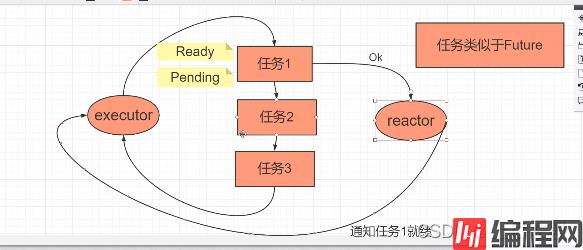目录简化版本 Future理解Future的模型async/awit 使用简化版本 Future // wake 函数 Reactor发现状态是ready 通知executor 函数
// wake 函数 Reactor发现状态是ready 通知executor 函数
trait SimpleFuture {
type Output;
fn poll(&mut self, wake: fn()) -> Poll<Self::Output>;
// fn poll(&mut self, wake: u32) -> Poll<Self::Output>;
}
enum Poll<T> {
Ready(T),
Pending,
}
future 返回的是Poll枚举 , 状态有Ready ,pending 状态
executor 调用 Future 任务,Ready 执行完成, pending 阻塞 执行其他任务
reactor 检查任务是否变成 ready
simpleFuture 是一个trait, 属于struct MySleep
use std::thread;
use std::time::Duration;
trait SimpleFuture {
type Output;
// fn poll(&mut self, wake: fn()) -> Poll<Self::Output>;
fn poll(&mut self, wake: u32) -> Poll<Self::Output>;
}
enum Poll<T> {
Ready(T),
Pending,
}
// 自定义循环技术
struct MySleeper {
polls: u64,
wake: u32, // 简化使用整数 替换函数
}
impl MySleeper {
fn new(wake: u32) -> Self {
MySleeper {
polls: 0,
wake: wake,
}
}
}
static mut FINISHED: bool = false;
impl SimpleFuture for MySleeper {
type Output = ();
fn poll(&mut self, wake: u32) -> Poll<Self::Output> {
// 简化编程 使用unsafe 使用外部的变量
unsafe {
if FINISHED {
Poll::Ready(())
} else {
self.wake = wake;
self.polls += 1;
println!("polls = {}", self.polls);
Poll::Pending
}
}
}
}
// 定义自定义Reactor
struct MyReactor {
wake: u32,
// 通知exector
handle: Option<thread::JoinHandle<()>>, // 线程句柄
}
impl MyReactor {
fn new() -> Self {
MyReactor {
wake: 0,
handle: None,
}
}
// 知道哪个wake 通知具体函数
fn add_wake(&mut self, wake: u32) {
self.wake = wake;
}
// check status
fn check_status(&mut self) {
if self.handle.is_none() {
let wake = self.wake;
// 模拟 通过死循环进行监控状态
let handle = thread::spawn(|| loop {
thread::sleep(Duration::from_secs(5));
unsafe {
//模拟future就绪,然后调用wake
FINISHED = true;
}
});
self.handle = Some(handle);
}
}
}
struct MyExecutor;
impl MyExecutor {
fn block_on<F: SimpleFuture>(mut myfuture: F, wake: u32) {
//阻塞执行future
loop {
match myfuture.poll(wake) {
Poll::Ready(_) => {
println!("my future is ok");
break;
}
Poll::Pending => unsafe {
while !FINISHED {
// 循环 每隔一秒钟检测一下
thread::sleep(Duration::from_secs(1));
}
}
}
}
}
}
fn main() {
let mut reactor = MyReactor::new();
let sleeper = MySleeper::new(5);
let wake = sleeper.wake;
reactor.add_wake(wake);
reactor.check_status();
MyExecutor::block_on(sleeper, wake);
}在简化版本的Future 对象中 有定义MyReactor, 和 MyExecutor, MyReactor wake 函数进行标记后调用自定义的check_staus 模拟Future的就绪,调用wake 函数通知, 在MyExector 的block_on 函数中 通过wake函数匹配状态 判读任务是否已经Ready
运行时状态的框架: async-std, futures 中已经实现executor不需要自己在实现。
异步编程中,rust的编程语言中只给我们提供trait Future, async-std, tokio,futures 等异步编程库 对其进行扩展,并且提供相对应的函数
async fn hello() {
println!("hello");
}
等价于下面函数
fn hello() -> impl Future<Output=()> {
async {
println!("hello");
}
}rust 标准库中 Future如下:
pub trait Future {
type Output;
fn poll(self: Pin<&mut Self>, cx: &mut Context<'_>) -> Poll<Self::Output>;
}
// Pin 可以创建不可移动Future,通过不可移动对象在他们字段中存储指针
struct MyFut {
a: i32,
ptr: *const i32, // 指针指向字段a 所在的内存首地址
}在闭包中使用async
use std::future::Future;
fn my_function() -> impl Future<Output = u8> {
let closure = async |x: u8| {
x
};
closure(5)
}
闭包在稳定版本还不支持,后续的版本中会支持 异步闭包
##### async lifetime
```rust
这个函数的生命周期
// fn foo_expand(x: &'a u8) -> impl Future<Output = u8> + 'a {
// async {
// *x
// }
// }
async fn foo(x: & u8) -> u8 {
*x
}
// async 函数返回一个Future的对象
fn Good() -> impl Future<Output = u8>{
// 异步代码块中,定义 变量后 调用foo_expand async 函数后进行await
async {
// x 修饰后 x 的生命周期有多长 就有多长
let x = 5;
foo_expand(&x).await
}
}
到此这篇关于rust异步编程详细讲解的文章就介绍到这了,更多相关rust异步编程内容请搜索编程网以前的文章或继续浏览下面的相关文章希望大家以后多多支持编程网!
--结束END--
本文标题: rust异步编程详细讲解
本文链接: https://www.lsjlt.com/news/175020.html(转载时请注明来源链接)
有问题或投稿请发送至: 邮箱/279061341@qq.com QQ/279061341
下载Word文档到电脑,方便收藏和打印~
2024-03-01
2024-03-01
2024-02-29
2024-02-29
2024-02-29
2024-02-29
2024-02-29
2024-02-29
2024-02-29
2024-02-29
回答
回答
回答
回答
回答
回答
回答
回答
回答
回答
0